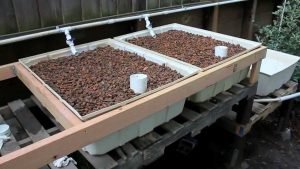Overview of Common Aquaponic Systems
Overview of Common Aquaponic Systems
Media Bed or Growbed
The media filled bed or flood and drain system is by far the most used aquaponics system. This system is used by backyard gardeners because it’s quite easy to understand and get started.
The water from the fish tank gets lifted with a solids lifting overflow to a filter where the first settable solids will be separated out. This is necessary if you use a large amount of fish. If you use small fish or a low stocking density you can pump the water straight to the growbeds.
Once the water is in the growbeds the level will start to rise, a siphon will drain the water back to the sump or fish tank. A media bed can be made with different media.

The fine solids that your filter didn’t catch will end up in the growbed. Bacteria and red worms will break the solids down and mineralize them for you which will increase nutrient availability.
You can plant about anything in the growbeds, just make sure it doesn’t get clogged with solids. A media-filled bed is highly susceptible to denitrification which means that the nitrifying bacteria in your growbed will die because of zones that are rotting.
Advantages
- Acts as mineralization
- Captures fine solids
- Acts as bio-media
Disadvantages
- Most of the times, a sump is needed
- Clogging of the growbed is possible
- Growbeds are heavy, need strong support
- Highest maintenance method, not suitable for commercial systems
Deep Water Culture or Floating Rafts
The deepwater culture or DWC is used in most commercial aquaponics systems. Most of these are modeled after the UVI design (University of the Virgin Islands). They set up a system that produces them tilapia and leafy vegetables. This system was proof that aquaponics can be commercially attractive if the market allows it.

The floating rafts are styrofoam boards with 2 to 3-inch net cups in them. Under the rafts is a steady and constant slow-flowing water mass that submerges the roots. Because the roots are submerged you will need to deliver extra oxygen under the rafts.
This system is good at producing small crops like lettuce, basil, okra,…
Read more about the DWC technique in my article: Floating raft aquaponics
Advantages
- A constant flow of water in the troughs
- The temperature of the water is stable because of the large mass of the water
- Ease of use
- Most commercial farms use this technique so it has a proven track record
Disadvantages
- Solid filtration need to be good
- Aeration is needed in the hydroponic trough
- A heavy system, not suitable for rooftops

Comments
Post a Comment